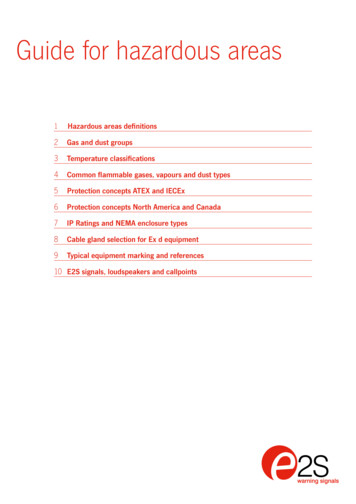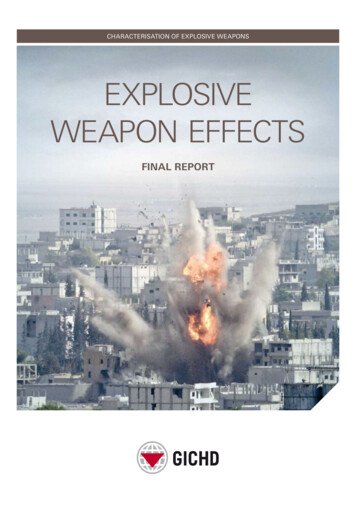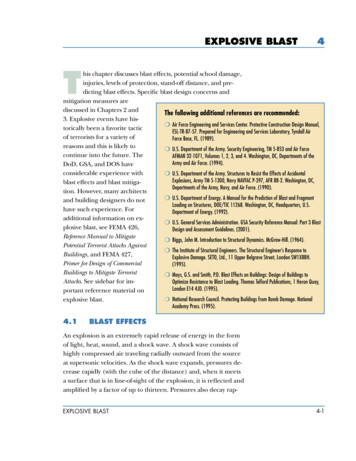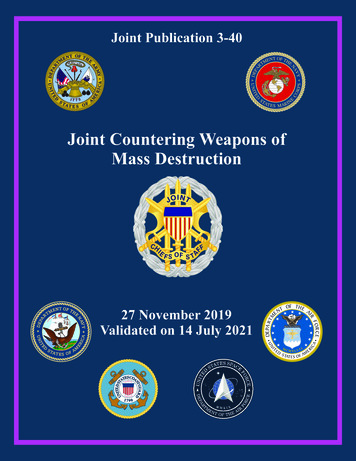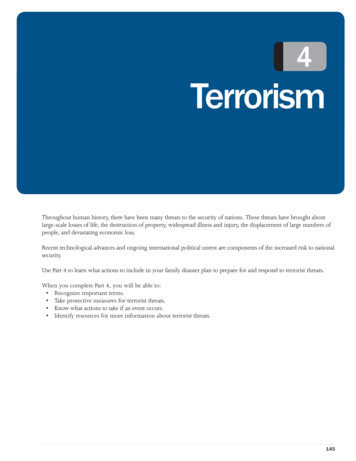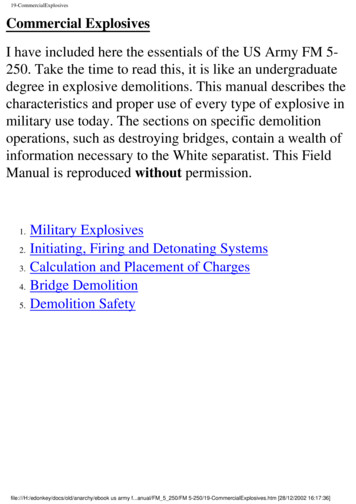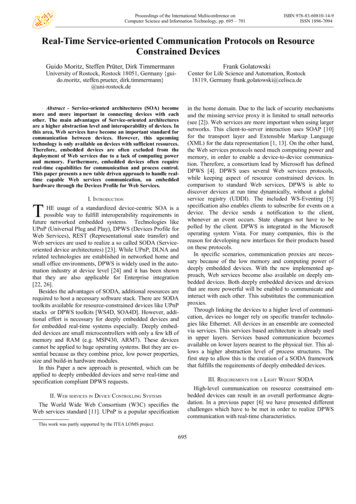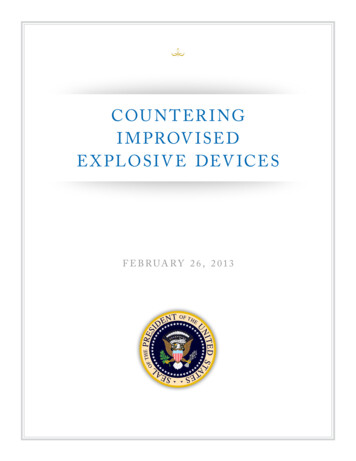
Transcription
COU N T ER I NGI M PROV I SE DE X PL OSI V E DEV ICE SF EBRUA RY 26, 2 013
COUNTERING IMPROVISED EXPLOSIVE DEVICESStrengthening U.S. PolicyImprovised explosive devices (IEDs) remain one of the most accessible weapons available toterrorists and criminals to damage critical infrastructure and inflict casualties, as wasdemonstrated in the attempted bombing of Northwest Flight 253 on December 25, 2009,the October 2010 air cargo plot, and the wars in Iraq and Afghanistan. The tactics used in IEDattacks continue to evolve as our adversaries seek to overcome countermeasures. ThisAdministration is expanding and broadening its counter-IED focus, building upon existing policyand strategy, which establish and implement measures to discover, prevent, protect against,respond to, recover from, and mitigate IED attacks and their consequences at home or abroad.We will enhance our effectiveness by: Leveraging, Integrating, and Aligning United States Government Efforts. The United StatesGovernment uses its military, law enforcement, diplomatic, regulatory, intelligence, andfinancial tools to counter IEDs globally. By actively and responsibly coordinating effortsacross departments and agencies, we can increase our effectiveness against IED threatswhile making the best use of existing capabilities and resources. Enhancing Our Focus on Protecting American Lives. IED attacks threaten American lives athome and abroad. Overseas, we are working with partner nations to reduce the IED threatto members of our military and diplomatic services, as well as U.S. citizens engaged incommercial travel and trade. To better meet the IED threat at home, we will seek toincorporate lessons learned abroad, while respecting legal and policy factors relevant todomestic counter-IED operations. Promoting Cooperation with Governmental, International, and Private Sector Partners.Sharing meaningful information about the IED threat with partners that are familiar withtheir communities increases the chance that suspicious activity will be recognized andreported to law enforcement authorities. The United States will work with partners toreduce the IED threat by sharing intelligence, building capacity, and developingcomplementary activities.Translating Policy into ActionsTo realize these policy objectives, we will employ the following priority capabilities and enablingtechnologies, which leverage existing investments, including:1. Increasing Domestic and International Engagement. We will seek to: Improve public awareness of IED threats and corresponding reporting of suspiciousactivity to local authorities through enhanced information sharing resources; Enhance information sharing with public and private sector partners on current IEDthreats and preparedness measures; and
Countering Improvised Explosive Devices Increase global participation and partnership in dialogues on counter-IED efforts andinformation sharing.2. Effectively Exploiting Information and Materials from IED Attacks. We will enhance ourcapability to identify IED networks, tactics, techniques and procedures through: Coordinating our IED collection and exploitation efforts, to better gather, share, andanalyze forensic, technical, and biometric information; and Enhancing policy, process, and mechanisms to analyze more effectively and share IEDexploitation results.3. Advancing Our Intelligence and Information Analysis. We will improve our understandingof technologies, trends, and networks through: Enhancing the reporting on and dissemination of criminal intelligence, incidentinformation, and suspicious activity involving explosives; Making counter-IED-specific intelligence resources more accessible to those who needit; Conducting multi-mode data analysis of IED patterns, trends, and tactics, techniques,and procedures to anticipate future IED threat evolutions; and Advancing the analytic tools available to better link information across sources,including financial information, biometrics, movements of people and technology, andother intelligence, in a secure manner.4. Maintaining Our Deployable Counter-IED Resources. We will maintain our scalable andlayered counter-IED capabilities, including personnel and equipment through: Developing and maintaining deployable United States Government counter-IEDresources; Assisting international partners with the development of deployable counter-IEDcapabilities; and Conducting exercises with deployable counter-IED resources.5. Screening, Detecting, and Protecting Our People, Facilities, Transportation Systems,Critical Infrastructure, as well as the Flow of Legitimate Commerce. We will continue todevelop and use advanced protection and detection technologies and capabilities by: Improving the performance of explosives screening, detection, and protectiontechnologies through prioritizing and coordinating research within the United States andwith our allies; and Effectively deploying and integrating these technologies and capabilities into our criticalinfrastructure and transportation systems to decrease the risk of an IED attack whilefacilitating legitimate trade and travel.6. Safeguarding Explosives and Select Precursor Materials. We will enhance our ability toidentify, prevent, and interdict the illicit diversion or transport of select materials used tomanufacture IEDs through:2
Countering Improvised Explosive Devices Promoting mechanisms for industry to better detect, report, and prevent theillegitimate acquisition, theft, or diversion of explosives and related materials;Enhancing enforcement of U.S. laws regulating commerce in explosives and materialsthat could be used as IED components;Increasing global awareness of actions to mitigate the use of munitions, precursorchemicals, and other components in IED construction;Evaluating methods to further restrict, control, or monitor select dual-use precursorsand components; andCoordinating domestic and international efforts to investigate, disrupt, dismantle andarrest members of networks involved in the financing and illicit movement of IEDcomponents.7. Coordinating and Standardizing Training and Equipment. Based on an updated assessmentof our national counter-IED training and equipment needs and priorities, we will improvecoordination to deliver standardized training to our domestic and international partnersthrough: Incorporating the lessons learned globally, including those from Iraq and Afghanistan,into our training and equipment requirements; Resourcing and implementing the Federal electronic countermeasures program toachieve a national capability; Enhancing national guidelines for bomb technicians; Finalizing and implementing national guidelines for explosives detection canine teams;and Leveraging existing technology transfer programs to address counter-IED capability gapsat the Federal, state, and local levels.8. Enhancing Our Operational Planning. We will develop interagency operational plans toadvance the Nation's ability to counter the use of IEDs, and establish measures to assessoverall effectiveness and progress. This will include: Developing and exercising a Federal counter-IED operational plan for a domestic ortransnational threat; Enhancing counter-IED preparedness planning for Federal, state, and local response;and Evaluating and reporting annually on interagency progress toward the goals set.The Joint Program Office for Countering IEDs, administered by the Attorney General throughthe Federal Bureau of Investigation (FBI), is an interagency group that will coordinate and trackprogress across the departments and agencies toward building these capabilities. The JointProgram Office will also provide metrics and assist departments and agencies in coordinatingtheir priorities.3
Countering Improvised Explosive DevicesExamples of SuccessDepartments and agencies are already at work implementing these policy objectives. Examplesinclude: Increased International Engagement. The Departments of State and Homeland Securityhave, working through the World Customs Organization, engaged global partners in aneffort to track and limit the flow of IED precursor materials into Afghanistan. Our allies andpartner nations have had similar success in stopping IED plots and limiting the flow ofexplosives precursors by raising awareness among the public and across industries. TheUnited States is also raising awareness of the global IED threat within the Group of 8, andother multilateral fora. Exploiting IED Information and Materials. The Departments of Defense and Justiceadapted law enforcement investigative and forensic expertise to fit the needs ofwarfighters. We are now able to use the materials generated through the exploitation ofthousands of IEDs to enhance counter-IED technologies and inform best practices andtraining. Safeguarding Explosive Materials. The Departments of State, the Treasury, Defense,Justice, and Homeland Security, and the Intelligence Community are working together, withthe assistance of international partners and multilateral organizations, to stem the flow ofexplosives precursors to Afghanistan and disrupt the illicit finance networks that supportthe production and use of IEDs. Domestically, we continue to seek to prevent terroristsfrom acquiring and converting these materials into IEDs, while maintaining access forlegitimate use. For example, a recent attempt to make explosives in West Texas wasstopped by the FBI when a chemical company reported suspicious purchases. Screen, Detect, and Protect. The Department of Homeland Security uses intelligencegathered by other departments and agencies to best position screening measures that keepexplosives out of transportation systems. Coordinating and Standardizing Training. By using the intelligence and exploitationinformation generated from IEDs found overseas, the FBI and the Department of HomelandSecurity have updated and enhanced the training and information provided to public safetybomb technicians, law enforcement, and first responders on how to respond to the latestterrorist IED tactics.ConclusionThe threat from IED use is likely to remain high in the coming decade and will continue toevolve in response to our abilities to counter them. A whole-of-government approach thatintegrates Federal, state, local, tribal, territorial, private sector, and global participation incounter-IED activities will best position the United States to discover plots to use IEDs in theUnited States, or against U.S. persons abroad, before those threats become imminent.4
Countering Improvised Explosive Devices . 3 Promoting mechanisms for industry to better detect, repo
